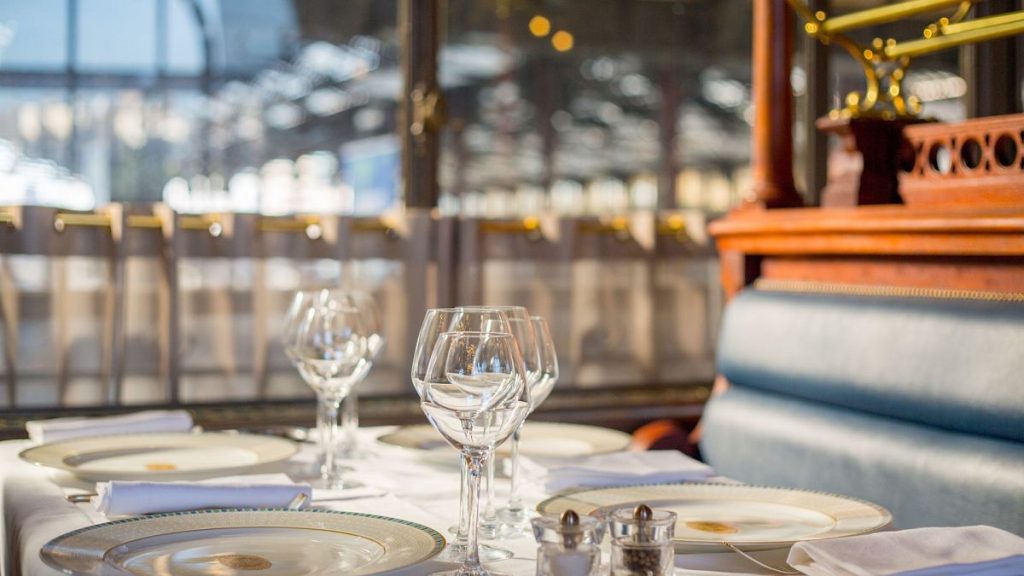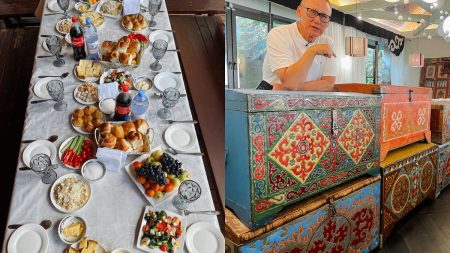Europe’s train stations are no longer just transit hubs; they’ve transformed into culinary destinations boasting an array of exceptional restaurants. Forget grabbing a quick, bland sandwich; these station-based brasseries and bistros offer a luxurious dining experience, making a pre-journey meal a highlight of your travels. From historic grandeur to modern elegance, these establishments cater to diverse tastes and budgets, offering everything from elevated takes on classic dishes to innovative, Michelin-starred creations.
In London, the Booking Office 1869 at St. Pancras Station offers a Victorian-inspired winter garden setting with towering palm trees and bespoke chandeliers. The menu features British classics and globally-influenced dishes, including miso-glazed aubergine and Scottish charcuterie boards. Paris’ Gare de Lyon houses Le Train Bleu, a Belle Époque masterpiece adorned with priceless watercolours, opulent chandeliers, and plush banquettes. This historic restaurant, frequented by artists and intellectuals, serves refined French cuisine, with highlights such as Provençal octopus stew and tableside-carved roast lamb.
Athens’ Rouf Station is home to the Wagon Restaurant, a unique dining experience housed within restored vintage train carriages, including a dining car from the iconic Simplon Orient Express. Inspired by Jules Verne’s “Around the World in 80 Days,” the menu offers dishes inspired by exotic locales, such as braised veal with a richly spiced tomato sauce. Stockholm Central Station features Luzette, a brasserie radiating 1920s charm with original architectural details and replicated vintage lamps. This elegant restaurant emphasizes local and seasonal ingredients, often sourced from their own fishing boat, focusing on fresh seafood and Scandinavian cuisine.
Amsterdam Centraal Station’s Grand Café Restaurant 1e Klas, designed by the renowned architect Pierre Cuypers, preserves the station’s original first-class waiting room ambience, complete with vintage clocks and Chinese urns. The eclectic menu ranges from gourmet burgers to omelettes, and the resident cockatoo, Elvis, adds a touch of quirky charm. While no longer a functioning station, Białowieża’s Tsar’s Restaurant in Poland offers a unique dining experience. Situated within a former royal hunting lodge station built for Tsar Alexander III, the restaurant features preserved original features and offers local delicacies, such as deer tenderloin with mushroom mayonnaise.
For those seeking culinary excellence, Zurich Hauptbahnhof’s The Counter, a Michelin-starred restaurant, provides an intimate and refined dining experience. The minimalist decor directs attention to the exquisite, albeit pricey, degustation menus, featuring innovative dishes like meringue with cherry and fennel. In Dorset, England, the Platform Restaurant offers a nostalgic railway dining experience within restored carriages, including the historic Brunel carriage used during WWI. The restaurant’s menu champions fresh seafood from England’s southwest coast, especially Cornish scallops.
These diverse dining establishments offer a far cry from the typical, uninspired train station food. They demonstrate how historic spaces can be reimagined into elegant and vibrant dining destinations, enhancing the travel experience by adding a touch of luxury and culinary exploration before or after a journey. Whether you crave classic dishes, exotic flavours, or Michelin-starred creations, these station restaurants provide a unique and satisfying dining adventure. They transform mundane waiting time into a delightful culinary experience, adding an element of elegance and indulgence to your travel itinerary.
The architectural details of these restaurants are often as captivating as the food they serve. From the Victorian winter garden ambiance of the Booking Office 1869 to the Belle Époque grandeur of Le Train Bleu, these establishments offer a feast for the eyes. The preserved historical features of the Grand Café Restaurant 1e Klas and the Tsar’s Restaurant further enhance the dining experience, adding a sense of nostalgia and historical significance. The unique setting of the Wagon Restaurant, nestled within restored train carriages, offers a truly unforgettable dining experience, immersing guests in the romance of train travel.
These culinary havens located within or near railway stations challenge the conventional notion of train station food, elevating it to a new level of sophistication and enjoyment. They offer travellers an opportunity to indulge in a memorable dining experience, whether it’s a quick pre-journey bite or a leisurely celebratory meal. The focus on fresh, local ingredients, innovative culinary techniques, and elegant presentation transforms a simple meal into a culinary adventure.
These restaurants also demonstrate the potential of repurposing historical spaces, breathing new life into old structures and preserving architectural heritage. They contribute to the revitalization of train stations, transforming them into vibrant hubs of activity and cultural experiences. These establishments not only satisfy culinary cravings but also offer a glimpse into history, art, and architectural design.
These examples demonstrate the growing trend of incorporating high-quality dining experiences into transportation hubs. They recognize that travellers appreciate the convenience and pleasure of enjoying a delicious meal before embarking on their journeys. Whether you’re looking for a quick bite or a luxurious dining experience, these station restaurants provide a welcome alternative to the predictable and often uninspiring food options typically found in transit settings.
These restaurants become destinations in themselves, attracting not only travellers but also local residents seeking a unique dining experience. They contribute to the overall ambiance and appeal of train stations, making them more welcoming and enjoyable spaces. They underscore the increasing emphasis on providing travellers with a holistic and enriching travel experience, one that extends beyond the mere act of transportation to encompass culinary exploration and cultural immersion.














